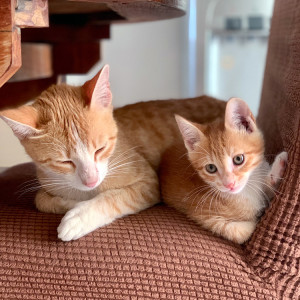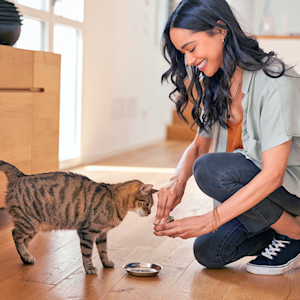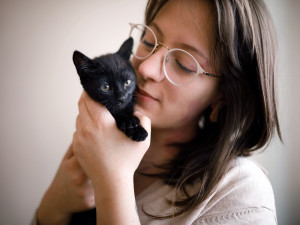
Share Article
In This Article:
Purchase the Necessary Bottle-Feeding Supplies Prepare the Kitten Formula Get Your Kitten Ready for Feeding Feed Your Kitten Frequently Asked Questions
If you find yourself looking after an orphaned kitten who is too young to eat on their own, you’ll have to take over many of the mama cat roles in rearing your kitten, including bottle-feeding. To bottle-feed a kitten, be sure to use kitten-specific formula and a nursing bottle with a small nipple.
Hold the kitten securely on their belly, not on their back, and feed them very slowly. Depending on the size and age of the kitten, the amount and frequency of feedings will vary, so be sure to estimate your kitten’s age appropriately.
Bottle-feeding a kitten can be extremely rewarding, not to mention adorable. At the same time, it can present unique challenges. Kittens this young are very fragile and require around-the-clock care until they are big enough and strong enough to develop some independence and eat on their own.
The best chance kittens have for growing up strong and healthy is to stay with their mothers until they are weaned. If you find nursing kittens with their mother, keep them together until the kittens are at least eight weeks old. Of course, sometimes fate has other plans, and you may have to step in to care for a kitten who doesn’t have their mother. There are a number of important things to know when caring for orphan kittens, and the more prepared you can be, the better.

Purchase the necessary bottle-feeding supplies.
Whenever possible, try to have the supplies you will need to care for a young kitten ahead of time. Bottle-feeding kittens need to eat every few hours and must be kept warm, so you won’t want to spend time collecting supplies if you have a hungry kitten waiting on their next meal.
Of course, orphaned kittens have a way of finding us at the most random times, so if you’re not prepared in advance, don’t fret. The basic supplies you’ll need to bottle feed a kitten are kitten formula, small bottles and nipples, a safe nesting box with heat support, soft bedding, and a small scale that weighs in grams. As your kitten grows, you’ll also want to invest in additional supplies for their physical and social-emotional health.
Buy bottles and nipples for feeding kittens.
Young kittens have teeny mouths and stomachs, so you’ll need supplies that are intended for bottle-feeding kittens. Many pet stores stock small nipples and bottles that hold the right volume of formula for a small kitten, or you may be able to get them from your veterinarian.
Avoid using large bottles; the formula you prepare can only be used for a short window of time. You’ll want to prepare just enough for each feeding to avoid waste. Additionally, large bottles may be more cumbersome to hold for such a small kitten or lead them to suck in too much air. The hole in the nipple should be just large enough for one drop of formula to drip out when the bottle is turned upside down; if the hole is too large, too much fluid will come out too quickly, which can be dangerous for nursing kittens. If the hole is too small, and no formula is coming out, you can carefully enlarge it with a scissor or needle.
Prepare the kitten formula.
Formula should be prepared according to the instructions on the package. Some may be powdered, while others are canned liquids. Ideally, offer formula that is room temperature or slightly warm — but never hot. You can create a warm water bath to gently warm the bottle by submerging it in a bowl of warm water.
It’s also very important to follow the package instructions regarding how long a serving of formula is safe to feed. Be careful not to use formula that is older than the guidelines, because it can spoil and introduce harmful germs. Young kittens are more vulnerable to illness, because their immune systems are immature, so don’t risk feeding them a formula that may no longer be fresh.
What formula is best to feed your kitten?
Kittens need kitten-specific formula that is the closest nutritional match to their mothers’ milk. Every species’ milk varies in its composition of sugars, proteins, and fats, so not every animal’s milk is an acceptable substitute for another species. Many pet stores and veterinary clinics carry kitten milk replacement formulas and in a pinch, a 24-hour emergency clinic may be able to provide enough formula to get through the night.
There are some homemade kitten formula recipes out there, but these should be analyzed with a healthy dose of scrutiny. Most have not been scientifically studied or evaluated to determine if they are safe and/or nutritionally balanced, and they are definitely not intended for long-term use. Avoid any recipes that include raw egg or unpasteurized milk as these can carry dangerous pathogens that could make a kitten sick.
Get your kitten ready for feeding.
It is a good idea to come up with a set schedule for feeding your kitten so you are consistent. Feeding frequency depends on your kitten’s weight and age. Newborn kittens may need to eat every two hours around the clock while older kittens may be able to go three or four-hour stretches between feedings.
As the time approaches for the next feeding, prepare all of your supplies including the formula, bottles, nipples, and a moist cotton ball first. You should keep your kitten cozy in their heated enclosure until you are all ready to feed in order to help maintain their body temperature.
Position kittens for bottle-feeding.
Kittens normally eat laying on their bellies with their paws on the ground, not on their backs like human babies. Be sure to feed your kitten in this upright position to avoid risks of choking and aspirating fluid into their lungs. Angle the nipple down into their mouth while tipping the bottle to minimize air ingestion.
You can gently raise their head up slightly to introduce the nipple into their mouth. Never squeeze the bottle while they are nursing as this can force too much liquid into their mouths. They should have an active suckling reflex that will allow them to suck from the bottle on their own.
Feed your kitten.
Offer your kitten the same amount of formula at each feeding initially, and be sure to keep track of how much they actually eat per feeding. This will help you track their progress and have a general idea of how much formula to prepare for the next feeding. Never force-feed a kitten who is refusing the bottle — this can lead to choking. Kittens who are cold, such as newly rescued kittens, must be warmed up before attempting to feed. Kittens without a suckling reflex or those who are cold or sick should be taken to a vet right away for more advanced care.
Kitten-feeding guidelines by age
Feeding guidelines vary by age and weight as far as how much to feed and how often. If you need help estimating your kitten’s age or figuring out how much to feed, be sure to consult with a veterinarian. As a general guideline, neonatal kittens who are just a few days old need to eat every two to three hours, or seven to nine times in a 24-hour period. This is based on a formulaopens in new tab that kittens should be fed about 25 milliliters of formula per 100 grams of body weight per day.
You can calculate how much your kitten should ideally consume per day and then divide that into feedings of two to three milliliters per 100 grams of weight each. For example, a neonatal kitten weighing 170 grams would need about 42.5 milliliters of formula per day (170g/100g = 1.7 x 25mL per 100 g = 42.5mL) and this amount would be divided into seven or eight feedings in 24 hours of about five milliliters each. This will ensure each feeding is a reasonable amount for their stomachs to hold and that they don’t go too long without food throughout the day.
A healthy, well-fed kitten should be gaining weight daily. A good way to track their progress is to weigh them daily — before a feeding at the same time each day. And keep a record of their weights in addition to how much they eat at each feeding and when they pee and poop. You can use these daily logs to catch any signs of concern early, and it will be very helpful to your veterinarian to review their feeding and weight patterns too.
Risk of overfeeding
Overfeeding a kitten carries health risks, so it is importantly to go slow and limit feedings. Kittens who overeat may be at risk for aspiration, or fluid getting into their lungs, as well as GI upset, especially diarrhea. A very young kitten with diarrhea can become dehydrated quickly so be sure to see a vet if you notice your kitten has diarrhea.
This is why it is very important to calculate how much each kitten should eat based on their weight and to be consistent with the amount for each feeding. The stomach capacity for a small kitten is estimated to be opens in new tab about four milliliters per 100 grams of body weight, so do not exceed this volume when feeding.
Complete the bottle-feeding process.
Once your kitten has finished their feeding, you’ll want to clean any formula off their face and gently rub their back to help them burp and eliminate any excess air in their stomachs. Then, get them ready to settle back into their nesting box.
If you have other caretaking tasks to do such as replacing their heating elements or cleaning their nest box, this is a good time to take care of these as well.
Cleaning your kitten
After each feeding, you’ll need to stimulate your kitten to pee and poop. Typically, the mother cat does this during and after nursing by grooming the kitten and licking their hind end. You’ll want to use a moist cotton ball to mimic this. Very gently dab your kitten’s hind end around their genitals and butt with the wet cotton ball until they go.
Young kittens cannot do this on their own, so it’s a very important part of the routine. If they get especially wet in the process or have pee/poop on their fur, gently clean them with warm water and dry them before returning them to their nest box. This helps keep them warm; any wet fur will lower their body temperature.
FAQs (People also ask):
How much should you bottle-feed your kitten?
This is very dependent on their weight and age. There are tables you can reference and calculations you can do based on their weight to determine the proper amount to feed.
How often should you bottle-feed your kitten?
This also depends on their weight and age. You will need to determine how much your kitten needs to eat per day and then divide that into feedings throughout the day, usually every two to three hours or so.
When should you stop bottle-feeding your kitten?
By three to four weeks old, kittens can start eating solid foods. You can gradually introduce a soft gruel-like food at this time. Over a week or two, they will take less from the bottle and eat more on their own until they are fully weaned.
References:

Dr. Amy Fox, DVM
Amy Fox, DVM is a small animal veterinarian in New York City with over thirteen years of experience in a mixture of general practice, emergency medicine, and shelter medicine. A lifelong animal lover, Dr. Fox studied biology in college and then worked as a veterinary nurse before pursuing veterinary school at Cornell University. Her expertise includes surgery, dentistry, and management of chronic conditions, and she is interested in toxicology, pain management, nutrition, care of senior pets, and educational outreach. Dr. Fox also enjoys writing about veterinary medicine and teaching, and her work has previously appeared in Spruce Pets. In her free time, she loves to cook, garden, go for long runs, and hang out with her goofy mixed-breed dog May, who provides never ending comic relief!
Related articles
![Woman playing with a black kitten.]()
5 Kitten Behavioral Milestones You Should Know
Keep track of all their fun phases with these guidelines.
![Woman feeding her kitten.]()
When Can a Kitten Eat Wet Food?
And how to know what kind they need.
![Relaxed girl holding a black kitten near her face.]()
What to Expect When Fostering a Kitten
Besides plenty of cuteness, of course.
![Newborn stray baby kitten, two weeks old adopted from the street in safe enviorment.]()
What Is Fading Kitten Syndrome?
Newborn kittens give you lots to worry about. Know the signs of this particular condition.
![Woman in a grey t-shirt and black overalls holding a sad looking ginger kitten]()
One Is the Loneliest Number: What to Know About Single Kitten Syndrome
Why adopting two kittens may be easier (and better for them) than adopting one.
![Woman using a laptop in bed, looking at her cat]()
What to Expect in the First 48 Hours With Your New Cat
Here’s how to help your rescue kitty feel at home.










